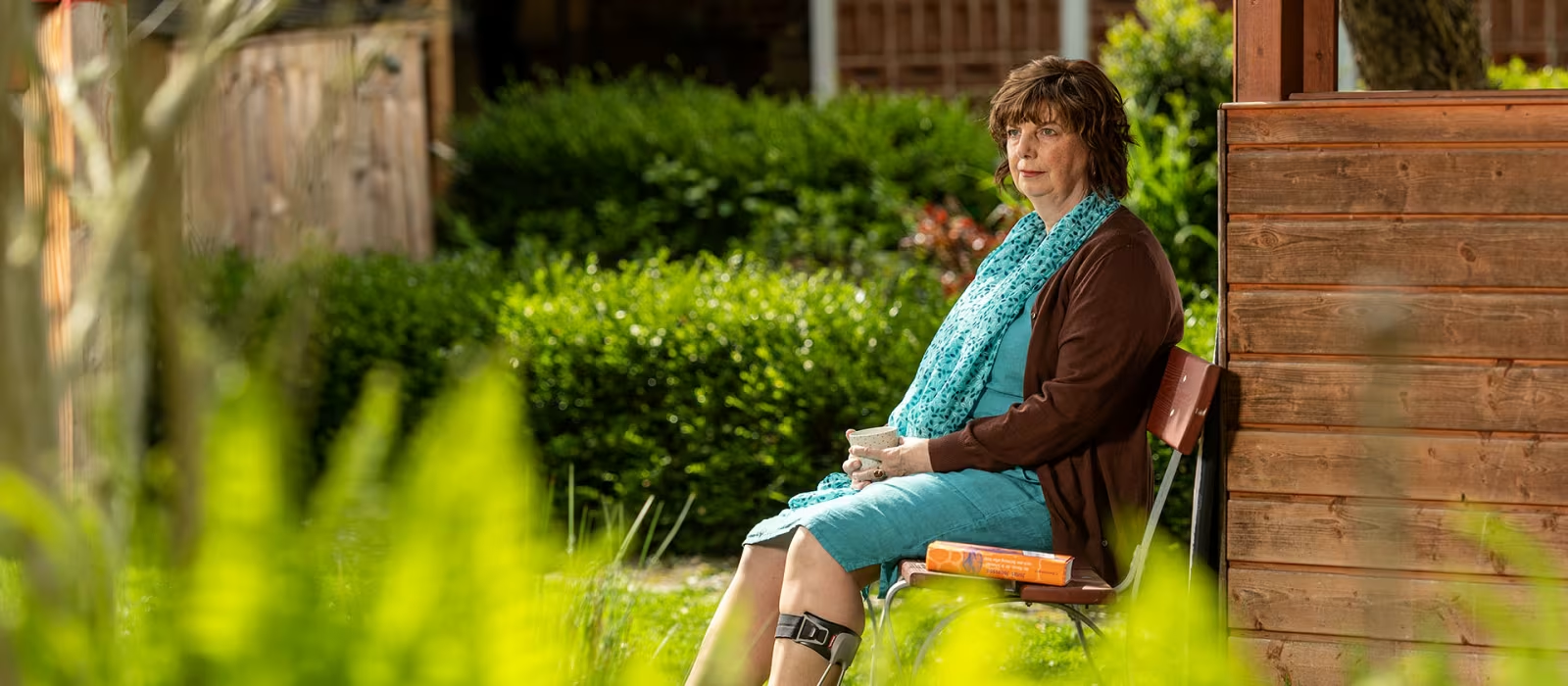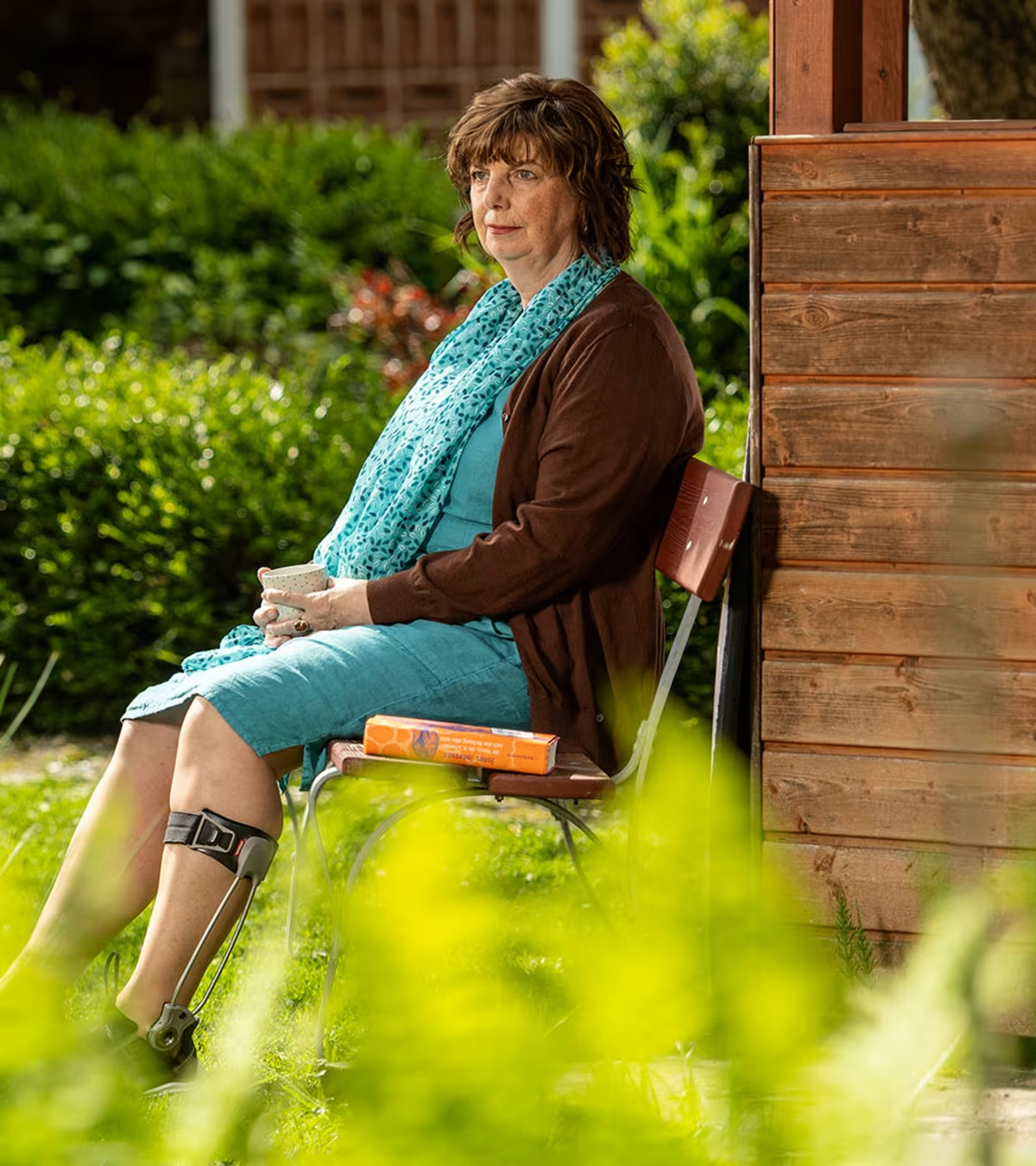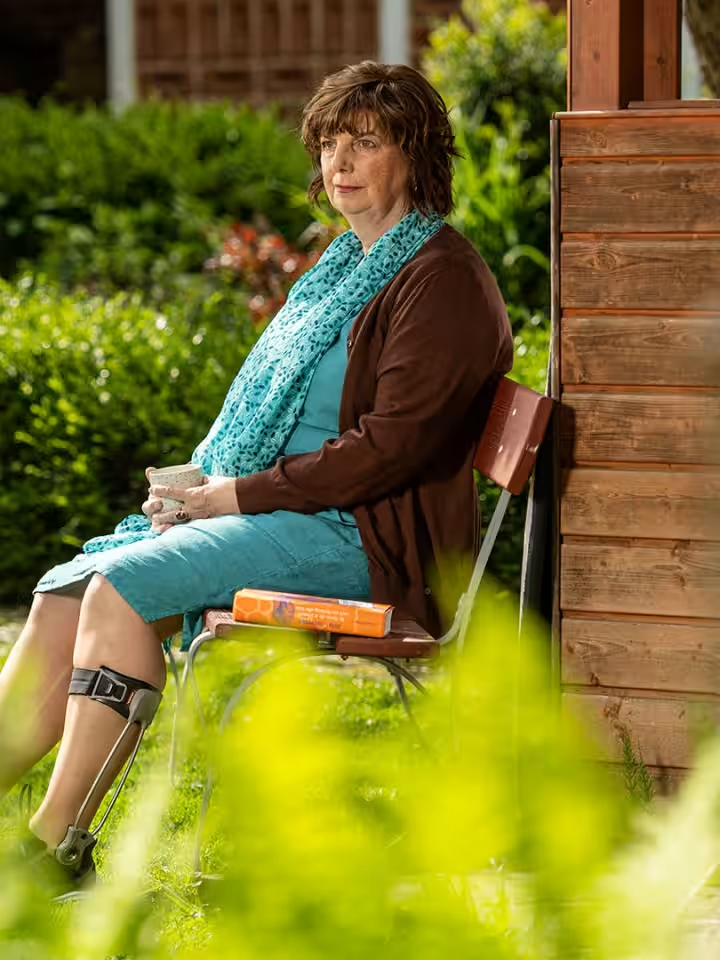Less knee pain. More life.



Take a new path – put a stop to osteoarthritis of the knee
Arthrosis is a widespread disease, with estimates indicating that more than 12 million people in Germany are affected by this joint disease. This group includes young and athletic people, too.
Arthrosis most often develops in the knee. The diagnosis can make those affected feel uncertain. Many fear that they will always have knee pain from now on and that they will need to take analgesics (pain medication) to be able to move. They wonder how long they will still be able to pursue their hobbies or climb the stairs, and at what point they may no longer be able to do anything without a prosthetic knee joint. Isn’t there any other way out of pain besides medication, no way to avoid or delay an operation?
Yes, there is! Put a stop to arthrosis. These days, there are good options for living an active life with arthrosis. In many cases, an orthosis can help reduce the pain – and help you regain your quality of life. Thanks to the appropriate orthosis, surgery can often be avoided. This website will tell you what you need to know about osteoarthritis of the knee. You will also find tips and information that will help you live your life with this disease on your own terms.
Devices for osteoarthritis of the knee
If you have arthrosis, an Ottobock orthosis can help alleviate pain and reduce the strain on your knee joints.
Symptoms of osteoarthritis of the knee
Osteoarthritis of the knee (or “knee OA” for short) is a degenerative condition of the knee joint. It is incurable and leads to progressive changes in the knee. In the initial stage of arthrosis, you don’t experience any pain or restrictions in movement, or only at times. With advanced osteoarthritis of the knee, pain and discomfort can increase. Most people develop arthrosis over their lives due to wearing of the joints. Risk factors such as obesity, joint malposition, lack of exercise, overloading and incorrect loading of the joints in some types of sports or injuries accelerate joint wear and tear and can also create the conditions for arthrosis to develop in young people.
Arthrosis changes the joint
Because it’s a degenerative joint disease, osteoarthritis of the knee typically starts with signs of degeneration and/or minimal damage in the joint cartilage. As time passes, the cartilage surface becomes rough and uneven. The joint no longer moves smoothly. It snags and grinds. Increasing friction leads to painful inflammation in the knee, and fluid is effused into the joint capsule. In this condition, also referred to as activated arthrosis, there is constant pain. In the advanced stage of arthrosis, cartilage damage increases and all the tissue involved in the joint is affected. The bones form spurs (osteophytes) to stabilise the joint but cause ankylosis, or stiffening, in the process. Knee pain occurs at increasingly shorter intervals and becomes more severe over time.
Disease progression: stages of arthrosis
Osteoarthritis of the knee is classified into four degrees of severity:
Arthrosis severity
The joint cartilage has invisible signs of degeneration. It’s less elastic than healthy cartilage and can’t recover well after being subjected to strain. Initial knee pain may occur under high strain.Arthrosis severity
The cartilage tissue becomes thinner. The cartilage surface becomes rough and uneven. The bones form initial spurs (osteophytes). The knee’s ability to bear weight is decreased. At this stage of arthrosis, the disease progression can be effectively slowed by exercises, weight loss and medical devices such as orthoses.Arthrosis severity
The cartilage has partly disappeared so that the bones begin to rub against each other in some places. X-rays show pronounced bone spurs and narrowing of the joint space. At this advanced stage, arthrosis causes considerable restrictions of movement and knee pain.Arthrosis severity
The joint space has narrowed considerably and the joint cartilage has almost completely disappeared. The bones are often damaged. The joint is deformed and often inflamed. In this final stage, joint replacement surgery – that is, a prosthetic knee joint – may be the best solution.

The vicious circle of arthrosis
Patients with osteoarthritis of the knee frequently get caught in a vicious circle:
In order to relieve the pain in their knee, the affected person exercises less and often adopts a certain posture to avoid discomfort. However, restricting their movement only provides short-term relief from pain. In the long run, a lack of exercise accelerates cartilage wear and increases pain in the knee. The affected person rests their knee even more often instead of exercising it, and the vicious circle closes.
Furthermore, the unnatural posture they take to avoid discomfort also puts excessive strain on other joints such as the hips, which can cause permanent damage.

Initial symptoms of osteoarthritis of the knee
The sooner osteoarthritis of the knee is diagnosed and actively addressed, the better the chances of getting knee pain under control, maintaining joint mobility for a long time to come and slowing down the progressive changes in the knee joint.
If you experience the following symptoms in your knee on a recurring basis, you should have it examined by an orthopaedist:
Knee pain after rest (start-up pain)
Knee pain after unusual exertion
Knee pain during certain movements
Knee stiffness
Grinding and cracking in the knee joint
Swelling and inflammation in the knee

4 results out of 4
Diagnosis and therapy for osteoarthritis of the knee
If you have knee pain or limited knee function, you should have it examined by an orthopaedist.
Diagnosing osteoarthritis of the knee
When talking to the doctor, you should give a detailed description of your knee problems and answer the physician’s questions precisely. In addition to the knee disorder, other health information such as arthroses in other joints, injuries, infections or chronic diseases may also be relevant to knee pain. During the examination, the physician will look at the knee and check its functions. They will then take an X-ray to see if any visible changes have already developed in the joint. In some cases, further examinations will be necessary to arrive at a diagnosis. Depending on the case, these include, for example, examinations of the blood or the joint fluid as well as other imaging procedures.

Therapy for osteoarthritis of the knee
There are three basic treatment methods for osteoarthritis of the knee: conservative (non-invasive) therapy, invasive joint-preserving therapy and invasive joint-replacing therapy. The term invasive is used for any treatment in which the doctor makes changes to the knee joint.
Orthoses can relieve knee pain
Knee or lower-leg-foot-braces, such as the Agilium Freestep, specifically relieve the painful areas in the knee joint and can provide sustainable relief from knee pain. This has been confirmed by studies. In many cases, orthoses can help those affected by osteoarthritis of the knee to stop using analgesics or decrease the dose of medication. Side effects from the medication are effectively avoided or reduced. Knee or lower-leg-foot-orthoses enable patients with osteoarthritis of the knee to move around and engage in sports with almost no pain. In this way, they’re able to break the vicious circle of pain, lack of exercise and progressive deterioration of the arthrosis.
“Most of my patients are very satisfied with the new orthosis. More than half of them have been able to avoid surgery so far.”

Taking a new path with orthoses from Ottobock
Find out about the experiences that patients with osteoarthritis of the knee have had and how they are taking new paths with orthoses from Ottobock.
Orthoses from Ottobock: solutions for different knee problems
Ottobock has developed tailor-made orthoses for different knee problems. Get an overview of the range of Ottobock orthoses for osteoarthritis of the knee here. Based on simple questions, Agilium Select takes just a few minutes to determine which brace is right for your knee problem and your lifestyle.
Osteoarthritis Agilium Line patient magazine
4 results out of 4
Active against arthrosis
Osteoarthritis of the knee cannot be cured, but you can effectively alleviate pain and discomfort and significantly improve your quality of life if you actively counteract the arthrosis with conscious nutrition and appropriate exercise.
Nutrition
Your meals should primarily consist of fruit and vegetables, salads, plant oils, nuts and seeds. Fish like mackerel, salmon and herring are rich in nutrients and Omega-3 fatty acids that curb inflammation. So if you like, we recommend eating healthy fish twice a week. Some spices not only improve the taste of food, they are also good for the joints: turmeric, nutmeg, cinnamon and coriander have an anti-inflammatory and decongestant effect. Chilli and ginger help to relieve pain. Meat can be eaten in moderation, but poultry is preferable. Beef and pork should rarely be consumed. It’s best to avoid processed convenience foods with high amounts of fat and sugar and to avoid alcohol and nicotine. If you are overweight, losing weight will take the strain off your joints and help you have less knee pain and feel lighter and fitter overall.

Exercise in everyday life
Regular exercise is essential to counteract the progressive changes caused by arthrosis, maintain knee function and relieve pain. You should therefore integrate more exercise into your daily routine. Take the stairs instead of the elevator, run small errands on foot or by bike instead of using the car and relax with an evening walk rather than sitting in front of the television. At work, you can do short exercises during breaks – you’ll see that this isn’t just good for your knee, it also refreshes your mind.

Christian Krone“Exercise is essential for arthrosis patients because muscle inactivity simply results in a joint that is unstable, weak and misaligned. And that’s why exercise, muscle training and compensating for misalignments have to be the key factors in counteracting arthrosis.”
Types of sports
In addition to everyday exercise, regularly engaging in certain types of sports is ideal for keeping arthrosis under control. Swimming, water aerobics, Nordic walking, biking or long walks, for example, maintain knee mobility and prevent pain. They also strengthen your leg muscles and promote your overall mobility and endurance. The most important rule is to keep moving, without overexerting yourself. This will have a positive effect on your knee joints, and you’ll feel better and more mobile in general.
However, it’s better to avoid sports that put a lot of strain on the knee joint due to abrupt stops, tight turns or high pressure at certain points. This includes most ball sports, martial arts or downhill skiing.

4 results out of 4
Agilium Move: special training for osteoarthritis of the knee
Get your knee in shape: watch the Agilium Move videos featuring special exercises for balance, strength and endurance for osteoarthritis of the knee. Our Agilium Move programme is designed especially for the needs of patients with arthrosis. It will help you strengthen the muscles in your legs and around the knee joint, increase the stability of your knee joints and become more mobile as a result. Join Christian Neureuther, a former professional skier, and get moving with Agilium Move!
Please note: Your health is important to us. Please take care not to overexert yourself. If in doubt, consult your doctor or physiotherapist.
Frequently asked questions about osteoarthritis of the knee
Back to everyday activities: three steps to an Ottobock orthotic
- Here you’ll find an overview of all the orthotics and supports that could potentially help you. Take the list with you to your next doctor’s appointment.
- Talk to your doctor about which orthotic is best suited to your symptoms and condition. Your doctor can then write you a prescription for the appropriate orthotic.
- Take your prescription to a medical supply company. They’ll give you your new orthotic and adjust it to fit your exact body measurements.
Active again thanks to the Agilium: four people talk about their lives
Effectiveness proven by studies
Use gentle treatment options – ranging from changes in nutrition to movement exercises through to orthoses – to break the vicious circle of arthrosis as early as possible. Clinical and biomechanical studies show significant, clinically relevant effects. See for yourself!

